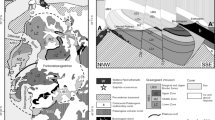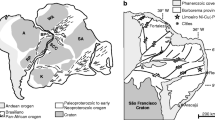Summary
The late Archaean Munni Munni Complex occupies an elliptical area of 9 by 25 km, the southern half of which is covered unconformably by a 2.7 Ga volcanic sequence. The Complex consists of a lower 1850 m thick Ultramafic Series (UMS) and an upper Gabbroic Series (GS) at least 3600 m thick, and is in the form of an elongate funnel. The UMS is made up of macrorhythmic cycles of dunite, wehrlite and clinopyroxenite, while the GS shows an uninterrupted fractionation trend from pigeonite gabbros through pigeonite-magnetite gabbros to granophyres. The base of the GS is very sharp, and marked by simultaneous appearance of cumulus plagioclase and pigeonite. GS cumulates show a monotonous upward increase in Fe/Mg and an absence of cyclic layering, indicating crystallization in a closed chamber.
The top of the UMS is a distinctive 30 m thick layer of bronzite-porphyritic orthocumulate websterite, which continues up the side walls as a marginal zone in contact with progressively more fractionated gabbros. A pyroxenite dyke intersects the sloping floor of the intrusion at a level close to the top of the UMS, and appears to have fed the uppermost layers of the UMS.
Cu-rich magmatic sulphides are weakly disseminated throughout the porphyritic websterite layer, increasing in abundance to 1–3% in a semi-continuous augite orthocumulate layer a few metres below the gabbro. This layer extends over 8.2 km, averages 2.5 m in thickness, and has an average grade of 2.9 g/t Pt + Pd + Au, 0.2% Ni and 0.3% Cu with local higher grade zones. In about 40% of intersections, peak PGE, Au, Cu and Ni grades are coincident, while in the remainder peak PGE grades are offset about 1–2 m below the peak Cu and Ni grades.
Coincident intersections are probably derived by homogenization of original offset intersections. Peak PGE grades become lower and more widely dispersed farther away from the intrusion walls.
PGE-enriched sulphides also occur close to the websterite-gabbro contact where the websterite occupies a marginal position on the side wall. The marginal websterite zone and the porphyritic websterite layer are physically contiguous and petrographically similar, and are probably correlative.
Microprobe data on cumulus pyroxenes indicate that the porphyritic websterite layer crystallised from a mixture of a relatively Mg- and Cr-rich “M” magma, parental to the Ultramafic Series, and an Fe-rich, strongly Cr-depleted gabbroic “G” magma. Pyroxenes from the PGE horizon are very low in Cr, suggesting that they crystallised from a “G”-rich hybrid.
The websterite formed as a result of an influx of dense “G” magma which mixed with hotter resident “M” magma. The upper few metres of the websterite, including the PGE-rich sulphides, accumulated during a period of quiescence at the end of the influx phase. The PGE-rich sulphides formed by fractional segregation of sulphide liquid from a 500 to 1000 m thick layer of silicate magma.
Munni Munni PGE mineralisation shows some striking similarities to that of the Great Dyke, particularly in the stratigraphic position of the mineralisation, the vertical distribution of PGE through the sulphide layer, and the lateral distribution of grades.
Zusammenfassung
Der spät-archaische Munni Munni-Komplex bedeckt eine elliptische Fläche von 9 × 25 km, deren südliche Hälfte diskordant von einer 2.7 Ga alten vulkanischen Abfolge überlagert wird. Der Komplex besteht aus einer unteren, 1850 m mächtigen ultramafischen Serie (UMS) und einer oberen gabbroischen Serie, die mindestens 3600 m mächtig ist und die Form eines länglichen Trichters hat. Die UMS besteht aus makrorhytmischen Zyklen von Dunit, Wehrlit und Klinopyroxenit, während die GS einen ununterbrochenen Fraktionierungs-Trend von Pigeonit-Gabbros über Pigeonit Magnetit-Gabbros zu Granophyren zeigt. Die Basis der GS ist scharf und wird durch das gleichzeitige Erscheinen von Cumulus-Plagioklas und Pigeonit definiert. GS Cumulate zeigen gegen das Hangende zu eine monotone Zunahme von Fe/Mg und ein Fehlen zyklischen Lagenbaues, was auf Kristallisation in einer geschlossenen Kammer hinweist.
Der oberste Teil der UMS ist eine deutlich ausgebildete, 30 m mächtige Lage von Bronzit-porphyritischem Orthokumulat-Websterit, welche sich an den Seitenwänden als randliche Zone fortsetzt, die in Kontakt mit zunehmend mehr fraktionierten Gabbros ist. Ein Pyroxenet-Gang durchschlägt den geneigten Boden der Intrusion im Bereich der obersten UMS, und dürfte als Zufuhrkanal für die obersten Lagen der UMS gedient haben.
Eine schwache Dissemination von Cu-reichen magmatischen Sulfiden ist im Gesamtbereich der porphyritischen Websterit-Lage zu beobachten; in einer Augit-Orthocumulat-Lage wenige Meter unterhalb des Gabbros steigt diese auf 1–3% Cu-Sulfide an. Diese Lage erstreckt sich über 8.2 km, ist im Durchschnitt 2.5 m mächtig, und hat einen Durchschnittsgehalt von 2.9 g/t Pt + Pd + Au, 0.2% Ni und 0.3% Cu, mit lokal reicheren Zonen. In etwa 40% der untersuchten Bohrkerne fallen maximale Gehalte an PGE, Au, Ni und Cu zusammen, während sonst maximale PGE-Gehalte etwa 1–2 m unterhalb der Cu- und Ni-Maxima auftreten.
Zusammenfallende Maxima dürften durch Homogenisation ursprünglich separater Maxima entstanden sein. Mit zunehmender Entfernung von den Rändern der Intrusion nehmen PGE Gehalte ab und werden unregelmäsiger.
PGE-reiche Sulfide kommen auch nahe am Websterit-Gabbro-Kontakt vor, wo der Websterit eine randliche Position einnimmt. Die randliche Websterit-Zone und die porphyritische Websterit-Lage hängen zusammen, sind petrographisch ähnlich, und sind wahrscheinlich zu korrellieren.
Mikrosonden-Analysen von Kumulus-Pyroxenen zeigen dass die porphyritische Websterit-Lage aus einer Mischung von relativ Mg- und Cr-reichem “M”-Magma dem die ultramafische Serie zuzuordnen ist, und einem Fe-reichen, Cr-armen gabbroischen “G”-Magma entstanden ist. Pyroxene aus der PGE-Lage führen sehr niedrige Cr-Gehalte; dies dürfte auf Kristallisation aus einem “G”-reichen Hybrid-Magma zurück gehen.
Der Websterit wurde als das Resultat der Zufuhr von dichtem “G”-Magma das sich mit höher temperiertem “M”-Magma mischte, gebildet. Die obersten Meter der Websterit Abfolge, mit den PGE-reichen Sulfiden, bildeten sich während einer ruhigen Periode am Ende der Influx-Phase. Die PGE-reichen Sulfide sind das Produkt fraktionierter Segregation von sulfidischer Schmelze aus einer 500 bis 1000 m mächtigen Lage silikatischen Magmas.
Die PGE-Mineralisation des Munni Munni-Komplexes ist der des Great Dyke von Zimbabwe in vieler Hinsicht ähnlich, besonders was die stratigraphische Position, die vertikale Verteilung der PGE in der Sulfid-Lage, und die laterale Verteilung der Gehalte betrifft.
Similar content being viewed by others
References
Barnes Sarah-Jane, Naldrett AJ (1986) Variations in platinum-group element concentrations in the Alexo Mine komatiite, Abitibi greenstone belt, northern Ontario. Geol Mag 123: 515–524
— Boyd R, Korneliussen A, Nilsson LP, Often M, Pedersen RB, Robins B (1988) The use of mantle normalisation and metal ratios in discriminating between the effects of partial melting, crystal fractionation and sulphide segregation on platinum group metals, gold, nickel and copper: examples from Norway. In: Prichard HM et al (eds), “Geo-Platinum 87”, Barking, Essex: Applied Science
Barnes St.J (1986) The effect of trapped liquid crystallization on cumulus mineral compositions in layered intrusions. Contrib Mineral Petrol 93: 524–531
—— (1986)a The distribution of chromium among orthopyroxene, spinel and silicate liquid at atmospheric pressure. Geochim Cosmochim Acta 50: 1889–1909
——Campbell IH (1988) Role of late magmatic fluids in Merensky-type platinum deposits: a discussion. Geology 16: 488–491
——Naldrett AJ (1985) Geochemistry of the J-M (Howland) Reef of the Stillwater Complex, Minneapolis Adit area. 1. Sulfide chemistry and sulfide olivine equilibrium. Econ Geol 80: 627–645
Campbell IH, Barnes SJ (1984) A model for the geochemistry of the platinum group elements in magmatic sulphide deposits. Can Mineral 22: 151–160
——Turner JS (1986) The influence of viscosity on fountains in magma chambers. J Petrol 27: 1–30
Donaldson MJ (1974) Petrology of the Munni Munni Complex, Roebourne, Western Australia. J Geol Soc Australia 21: 1–16
Hoatson DM (1986) Geology of the Munni Munni layered intrusion (1 : 20,000 scale map). Bureau Mineral Resources, Geology and Geophysics, Canberra, Australia
—England RN (1986) Platinum group minerals from a layer in the Munni Munni Complex of the Pilbara Block. Bureau of Mineral Resources, Geology and Geophysics Research Newsletter No. 5, 1–2
——Keays RR (1987) Platinum group geochemistry of the Munni Munni layered intrusion, West Pilbara Block, Western Australia: an example of the formation of platiniferous sulphide horizons by crystal fractionation and magma mixing (abstract). In: Platiniferous Horizons in Layered Intrusions, Univ of New South Wales School of Mines, Sydney, N.S.W.
Keays RR, Campbell IH (1981) Precious metals in the Jimberlana intrusion, Western Australia: implications for the genesis of platinum ores in layered intrusions. Econ Geol 76: 1118–1141
Kerr RC, Tait SR (1986) Crystallisation and compositional convection in a porous medium with application to layered intrusions. J Geophys Res 91: 3591–3608
Naldrett AJ (1981) Nickel sulphide deposits: classification, composition and genesis. Econ Geol 75th anniversary volume: 628–685
Peach CL, Mathez EA, Keays RR (1989) Sulfide-silicate melt distribution coefficients for the noble metals as deduced from MORBS (abstract). 5th International Platinum Symposium, Helsinki, Bull Geol Soc Finland 68: 58
Prendergast MD, Keays RR (1989) Controls on a platinum group element mineralization and the origin of the PGE-rich Main Sulphide Zone in the Wedza Subchamber of the Great Dyke, Zimbabwe: implications for the genesis of, and exploration for, stratiform PGE mineralization in layered intrusions. In:Prendergast MD, Jones MJ (eds), Magmatic Sulphides-the Zimbabwe Volume. Inst Mining Metall, London, pp43–70
——Wilson AH (1989) The Great Dyke of Zimbabwe. II. Mineralization and mineral deposits. In:Prendergast MD, Jones MJ (eds) Magmatic Sulphides-the Zimbabwe Volume. Inst Mining Metall, London, pp21–42
Rajamani V, Naldrett AJ (1978) Partitioning of Fe, Co, Ni and Cu between sulfide liquid and basaltic melts and the composition of Ni-Cu sulfide deposits. Econ Geol 73: 82–93
Ross JR, Keays RR (1979) The distribution of the precious metals in the ores and host rocks of Kambalda, Western Australia. Can Mineral 17: 417–435
von Gruenewaldt G (1970) On the phase change orthopyroxene-pigeonite and the resulting textures in the main and upper zones of the Bushveld Complex in the Eastern Transvaal. Geol Soc South Africa, Special Publ 1: 67–73
Williams CR, Nisbet BW, Hoatson DM (1989) Platinum group element mineralization in the Munni Munni Complex, Pilbara Block, Western Australia. Australian Inst Mining Metall, in press
Wilson AH, Prendergast MD (1989) The Great Dyke of Zimbabwe. I. Tectonic setting, stratigraphy, petrology, structure, emplacement and crystallization. In:Prendergast MD, Jones MJ (eds), Magmatic Sulphides-the Zimbabwe Volume. Inst Mining Metall, London, pp1–20
—Tredoux M (1989) Lateral and vertical distribution of the platinum group elements in the PI pyroxenite layer of the Darwendale subchamber of the Great Dyke, Zimbabwe, and petrogenetic controls on the sulphide mineralization. Econ Geol, in press
Author information
Authors and Affiliations
Additional information
With 7 Figures and 1 Plate
Rights and permissions
About this article
Cite this article
Barnes, J., McIntyre, J.R., Nisbet, B.W. et al. Platinum group element ,mineralisation in the Munni Munni Complex, western Australia. Mineralogy and Petrology 42, 141–164 (1990). https://doi.org/10.1007/BF01162688
Received:
Accepted:
Issue Date:
DOI: https://doi.org/10.1007/BF01162688




